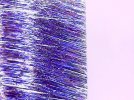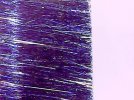- Joined
- Oct 4, 2021
- Messages
- 2,540
Background: I've had the CGSW 4" stones for KME for about 6 months and just recently got a set of the Venev 6" Orion stones to complement my new Hapstone system. The Venev set I got has 100% diamond concentration, which may account for the difference in the results discussed below. According to Gritomatic, the 25% concentration stones show fewer fine scratches.
Anyway, my subjective impression from using both sets was that the CGSW 5 micron stone produced a glassier, more mirrored finish than the Venev F1200 stone. To test the theory, I sharpened both sides of a beater knife using the Venev stones up to the F800 grit. Then I sharpened the show side of the blade using the CGSW 5 micron stone and the lock side with the Venev F1200 and compared the results. To be as fair as possible, I only used 4" of the Venev stone.
The contestants:
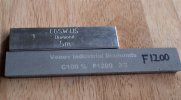


You can see in the last pic that the Venev stone
has a much thicker diamond layer (3mm vs. 1mm), while the CGSW stone has a much thicker aluminum blank.
And this is what their respective finishes look like under my el-cheapo USB microscope. I tried to capture the finishes as best I could:
Venev:
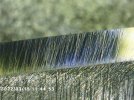
And CGSW:
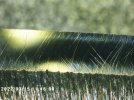
And finally, I tried -- without a lot of success -- to capture the finishes on video:
To me, the clear winner between the CGSW 5 micron and the Venev 100% concentration F1200 is the CGSW, based solely on the quality of the finishes they produce. I also think the CGSW stone has better diamond layer uniformity and flatness -- the latter probably due to the CGSW's much thicker aluminum blank. On the other hand, the Venev stones stay wet longer and thus require less interruption to keep the stones lubricated. And of course the Orion series' diamond laye is 3x thicker than CGSW's.
That's all, folks!
Anyway, my subjective impression from using both sets was that the CGSW 5 micron stone produced a glassier, more mirrored finish than the Venev F1200 stone. To test the theory, I sharpened both sides of a beater knife using the Venev stones up to the F800 grit. Then I sharpened the show side of the blade using the CGSW 5 micron stone and the lock side with the Venev F1200 and compared the results. To be as fair as possible, I only used 4" of the Venev stone.
The contestants:



You can see in the last pic that the Venev stone
has a much thicker diamond layer (3mm vs. 1mm), while the CGSW stone has a much thicker aluminum blank.
And this is what their respective finishes look like under my el-cheapo USB microscope. I tried to capture the finishes as best I could:
Venev:

And CGSW:

And finally, I tried -- without a lot of success -- to capture the finishes on video:
To me, the clear winner between the CGSW 5 micron and the Venev 100% concentration F1200 is the CGSW, based solely on the quality of the finishes they produce. I also think the CGSW stone has better diamond layer uniformity and flatness -- the latter probably due to the CGSW's much thicker aluminum blank. On the other hand, the Venev stones stay wet longer and thus require less interruption to keep the stones lubricated. And of course the Orion series' diamond laye is 3x thicker than CGSW's.
That's all, folks!
Last edited:



